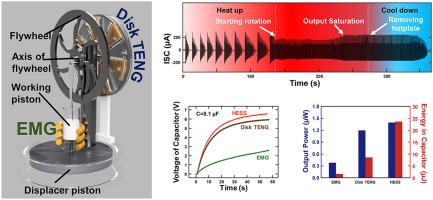Nano Energy ( IF 16.8 ) Pub Date : 2021-09-11 , DOI: 10.1016/j.nanoen.2021.106508 Jonghyeon Yun 1, 2 , Inkyum Kim 1, 2 , Daewon Kim 2, 3

|
Tremendous energy is being wasted without any proper utilization despite the energy crisis and global warming. Especially, enormous thermal energy is wasted, which is generated from the industrial fields. To handle this issue, technology is highly desired to harvest this wasted thermal energy. Herein, a hybridized energy harvesting system based on Stirling engine (HESS) is proposed in order to harvest the wasted thermal energy in industrial fields. The developed HESS is composed of a disk triboelectric nanogenerator (disk TENG) and electromagnetic generator (EMG) based on Stirling engine that converts thermal energy into mechanical energy. Hence, the HESS can harvest the electricity from the mechanical energy converted from the thermal energy owing to the Stirling engine and shows its great stability of the performance by generating electrical output for more than 2 h without any specific degradation. Each part of the single EMG and the disk TENG in the HESS respectively generates an output power of 0.384 μW at 60 Ω and 1.2 μW at 30 MΩ, and the HESS can generate 1.4 μW at 9 MΩ by integrating each generated power. Moreover, the fabricated HESS generates 14.51 times more electrical energy than generated electrical energy through the single EMG. Considering these results, the next-generation heat recovery system can be implemented with the HESS by converting the wasted thermal energy into electrical energy in the industrial fields.
中文翻译:

基于斯特林发动机的混合能量收集系统面向下一代工业领域热回收系统
尽管存在能源危机和全球变暖,但在没有任何适当利用的情况下浪费了大量能源。特别是工业领域产生的大量热能被浪费掉。为了解决这个问题,非常需要技术来收集这种浪费的热能。在此,提出了一种基于斯特林发动机(HESS)的混合能量收集系统,以收集工业领域中浪费的热能。开发的HESS由盘式摩擦纳米发电机(disk TENG)和基于斯特林发动机的电磁发电机(EMG)组成,可将热能转化为机械能。因此,HESS 可以从斯特林发动机的热能转换的机械能中获取电能,并且通过产生超过 2 小时的电力输出而没有任何特定的退化,显示出其性能的极大稳定性。HESS 中单个 EMG 和磁盘 TENG 的每个部分在 60 Ω 和 30 MΩ 时分别产生 0.384 μW 和 1.2 μW 的输出功率,HESS 通过对每个产生的功率进行积分可以在 9 MΩ 时产生 1.4 μW。此外,制造的 HESS 产生的电能是通过单个 EMG 产生的电能的 14.51 倍。考虑到这些结果,下一代热回收系统可以通过 HESS 在工业领域将浪费的热能转化为电能来实现。HESS 中单个 EMG 和磁盘 TENG 的每个部分在 60 Ω 和 30 MΩ 时分别产生 0.384 μW 和 1.2 μW 的输出功率,HESS 通过对每个产生的功率进行积分可以在 9 MΩ 时产生 1.4 μW。此外,制造的 HESS 产生的电能是通过单个 EMG 产生的电能的 14.51 倍。考虑到这些结果,下一代热回收系统可以通过 HESS 在工业领域将浪费的热能转化为电能来实现。HESS 中单个 EMG 和磁盘 TENG 的每个部分在 60 Ω 和 30 MΩ 时分别产生 0.384 μW 和 1.2 μW 的输出功率,HESS 通过对每个产生的功率进行积分可以在 9 MΩ 时产生 1.4 μW。此外,制造的 HESS 产生的电能是通过单个 EMG 产生的电能的 14.51 倍。考虑到这些结果,下一代热回收系统可以通过 HESS 在工业领域将浪费的热能转化为电能来实现。电能是通过单个 EMG 产生的电能的 51 倍。考虑到这些结果,下一代热回收系统可以通过 HESS 在工业领域将浪费的热能转化为电能来实现。电能是通过单个 EMG 产生的电能的 51 倍。考虑到这些结果,下一代热回收系统可以通过 HESS 在工业领域将浪费的热能转化为电能来实现。










































 京公网安备 11010802027423号
京公网安备 11010802027423号